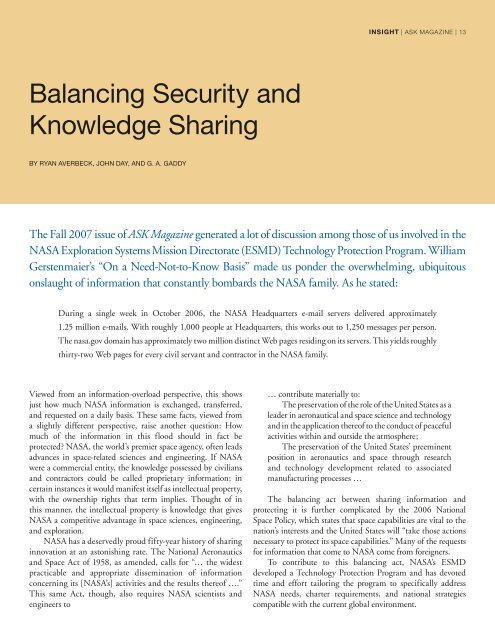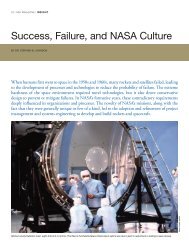Balancing Security and Knowledge Sharing - NASA ASK Magazine
Balancing Security and Knowledge Sharing - NASA ASK Magazine
Balancing Security and Knowledge Sharing - NASA ASK Magazine
Create successful ePaper yourself
Turn your PDF publications into a flip-book with our unique Google optimized e-Paper software.
<strong>Balancing</strong> <strong>Security</strong> <strong>and</strong><br />
<strong>Knowledge</strong> <strong>Sharing</strong><br />
BY RYAN AvERBECK, JOHN DAY, AND g. A. gADDY<br />
INSIGHT | <strong>ASK</strong> MAGAZINE | 13<br />
The Fall 2007 issue of <strong>ASK</strong> <strong>Magazine</strong> generated a lot of discussion among those of us involved in the<br />
<strong>NASA</strong> Exploration Systems Mission Directorate (ESMD) Technology Protection Program. William<br />
Gerstenmaier’s “On a Need-Not-to-Know Basis” made us ponder the overwhelming, ubiquitous<br />
onslaught of information that constantly bombards the <strong>NASA</strong> family. As he stated:<br />
During a single week in October 2006, the <strong>NASA</strong> Headquarters e-mail servers delivered approximately<br />
1.25 million e-mails. With roughly 1,000 people at Headquarters, this works out to 1,250 messages per person.<br />
The nasa.gov domain has approximately two million distinct Web pages residing on its servers. This yields roughly<br />
thirty-two Web pages for every civil servant <strong>and</strong> contractor in the <strong>NASA</strong> family.<br />
Viewed from an information-overload perspective, this shows … contribute materially to:<br />
just how much <strong>NASA</strong> information is exchanged, transferred, The preservation of the role of the United States as a<br />
<strong>and</strong> requested on a daily basis. These same facts, viewed from leader in aeronautical <strong>and</strong> space science <strong>and</strong> technology<br />
a slightly different perspective, raise another question: How <strong>and</strong> in the application thereof to the conduct of peaceful<br />
much of the information in this flood should in fact be activities within <strong>and</strong> outside the atmosphere;<br />
protected? <strong>NASA</strong>, the world’s premier space agency, often leads The preservation of the United States’ preeminent<br />
advances in space-related sciences <strong>and</strong> engineering. If <strong>NASA</strong> position in aeronautics <strong>and</strong> space through research<br />
were a commercial entity, the knowledge possessed by civilians <strong>and</strong> technology development related to associated<br />
<strong>and</strong> contractors could be called proprietary information; in manufacturing processes …<br />
certain instances it would manifest itself as intellectual property,<br />
with the ownership rights that term implies. Thought of in The balancing act between sharing information <strong>and</strong><br />
this manner, the intellectual property is knowledge that gives protecting it is further complicated by the 2006 National<br />
<strong>NASA</strong> a competitive advantage in space sciences, engineering, Space Policy, which states that space capabilities are vital to the<br />
<strong>and</strong> exploration. nation’s interests <strong>and</strong> the United States will “take those actions<br />
<strong>NASA</strong> has a deservedly proud fifty-year history of sharing necessary to protect its space capabilities.” Many of the requests<br />
innovation at an astonishing rate. The National Aeronautics for information that come to <strong>NASA</strong> come from foreigners.<br />
<strong>and</strong> Space Act of 1958, as amended, calls for “… the widest To contribute to this balancing act, <strong>NASA</strong>’s ESMD<br />
practicable <strong>and</strong> appropriate dissemination of information developed a Technology Protection Program <strong>and</strong> has devoted<br />
concerning its [<strong>NASA</strong>’s] activities <strong>and</strong> the results thereof ….” time <strong>and</strong> effort tailoring the program to specifically address<br />
This same Act, though, also requires <strong>NASA</strong> scientists <strong>and</strong> <strong>NASA</strong> needs, charter requirements, <strong>and</strong> national strategies<br />
engineers to compatible with the current global environment.
14 | <strong>ASK</strong> MAGAZINE<br />
To help mitigate the challenges associated with the<br />
establishment of the Technology Protection Program, ESMD<br />
enlisted our services to form the core of the Mission Critical<br />
Information (MCI) assessment team. The MCI assessment team<br />
is the “nervous system” of the ESMD Technology Protection<br />
Program. Ryan Averbeck’s technology protection experience<br />
related to the Department of Defense <strong>and</strong> commercial sectors<br />
comes from an extensive background as a counterintelligence<br />
agent <strong>and</strong> service as an assistant director at the Army Research<br />
<strong>and</strong> Technology Protection Center (ARTPC). John Day is<br />
a board-certified security management professional <strong>and</strong> has<br />
extensive experience implementing security programs at <strong>NASA</strong>.<br />
G. A. Gaddy brings extensive experience <strong>and</strong> insight as a<br />
Department of Defense scientist, former National Academies<br />
of Science National Research Council postdoctoral fellow at<br />
Langley Research Center, <strong>and</strong> a senior technology protection<br />
engineer at the ARTPC. The team’s experience proved critical<br />
in the development of the Technology Protection Program<br />
processes. Our varied backgrounds <strong>and</strong> experiences provided a<br />
multidiscipline foundation for <strong>NASA</strong> to develop <strong>and</strong> implement<br />
a unique, customized Technology Protection Program.<br />
The ESMD Technology Protection Program process<br />
requires the impartial MCI assessment team to review <strong>and</strong><br />
evaluate all pertinent technical aspects <strong>and</strong> documentation<br />
related to the research, components, systems, elements, projects,<br />
<strong>and</strong> programs under consideration. The team’s analysis includes,<br />
but is not limited to, the daunting task of horizontal crossreferencing.<br />
This involves referencing technologies against the<br />
Militarily Critical Technologies List, the Developing Science<br />
<strong>and</strong> Technologies List, the export control criteria from the<br />
Department of State, <strong>and</strong> other sources. The MCI assessment<br />
team also conducts analysis to determine if research or technology<br />
under development is “state of the world” versus “state of the<br />
art,” <strong>and</strong> revolutionary versus evolutionary.<br />
For example, if <strong>NASA</strong> were developing a Pentium 4<br />
processor <strong>and</strong> the rest of the world possessed Pentium 3<br />
processors, the technology could be considered evolutionary<br />
in nature, since Moore’s Law would lead us to believe the<br />
rest of the world would catch up with a Pentium 4 of their<br />
own in relatively short order. In this instance, the Pentium 3<br />
processors are state-of-the-world technology, <strong>and</strong> the Pentium 4<br />
is not a large enough order of magnitude improvement<br />
to be revolutionary or state of the art. If <strong>NASA</strong> were<br />
developing a Pentium 4 processor while the rest of the<br />
world possessed Commodore 64 processors, this technology<br />
would then be revolutionary since it represents orders of<br />
magnitude improvement.<br />
After conducting technical discussions with <strong>NASA</strong> <strong>and</strong><br />
contractor subject-matter experts, the MCI team presents its<br />
findings <strong>and</strong> recommendations to <strong>NASA</strong> management for<br />
an MCI determination decision. If information is designated<br />
mission critical, the team then works with <strong>NASA</strong> management<br />
<strong>and</strong> Technology Protection Program personnel to develop<br />
the appropriate procedures to protect it. Protection does not<br />
necessarily mean the information or technology cannot be<br />
shared or disclosed. In most cases, it provides the foundation<br />
for <strong>NASA</strong> management to make informed decisions regarding<br />
appropriate dissemination.<br />
An MCI designation is not necessarily permanent. For<br />
example, during a recent assessment, a particular set of test results<br />
was deemed MCI by <strong>NASA</strong> management. This determination<br />
was largely based on the active steps a foreign entity was taking<br />
to obtain the information. When an acquisition decision was<br />
later made by <strong>NASA</strong> management to pursue another engineering<br />
solution, the MCI was no longer of great value to <strong>NASA</strong> or<br />
the foreign entity, so the Agency removed the mission-critical<br />
designation from the test results.<br />
In light of the information overload problem described by<br />
Gerstenmaier, the Technology Protection Program assists in<br />
identifying <strong>and</strong> protecting <strong>NASA</strong>’s information from unauthorized<br />
release or inadvertent disclosure. The team helps the <strong>NASA</strong> family<br />
underst<strong>and</strong> <strong>and</strong> mitigate a multitude of concerns:
WITHIN THE SECuRITy ANd PRoTECTIoN dISCIPlINES, oNE AxIoM AlWAyS<br />
HoldS TRuE: THE bEST CouNTERMEASuRE To THREATS IS AN EduCATEd<br />
ANd ENGAGEd WoRKfoRCE.<br />
• How much of <strong>NASA</strong>-controlled information is<br />
inadvertently released outside approved channels<br />
because employees are overwhelmed by volumes of<br />
information?<br />
• How well-trained <strong>and</strong> equipped is <strong>NASA</strong> to “know”<br />
what would require protection? We are currently charged<br />
with protecting several categories of information such<br />
as export controlled, contractor proprietary, sensitive<br />
but unclassified, classified (such as confidential, secret,<br />
<strong>and</strong> top secret) information, <strong>and</strong> the recently codified<br />
MCI, just to name a few.<br />
• Does the <strong>NASA</strong> team (civilians <strong>and</strong> contractors)<br />
underst<strong>and</strong> the nature <strong>and</strong> capabilities of those that<br />
wish to obtain our controlled information via nefarious<br />
means or by simply exploiting our information overload?<br />
When was the last time employees requested or received<br />
a threat briefing from <strong>NASA</strong> counterintelligence?<br />
• Are we adequately<br />
prepared <strong>and</strong> staffed as an agency<br />
to review thous<strong>and</strong>s<br />
of pages of information to<br />
determine what should receive protection?<br />
• What are the benefits <strong>and</strong> ramifications of controlling<br />
versus sharing critical <strong>NASA</strong> information?<br />
The Technology Protection Program helps streamline<br />
information dissemination by giving the <strong>NASA</strong> workforce<br />
guidance on the limits of sharing particular information.<br />
Identifying the specific information that requires protection<br />
makes information sharing easier <strong>and</strong> clearer. One of the major<br />
factors in the success of the <strong>NASA</strong> technology-protection model<br />
is the MCI team’s underst<strong>and</strong>ing of programs’ cost, schedule,<br />
<strong>and</strong> performance drivers. The entire technology-protection<br />
team respects <strong>NASA</strong>’s mission, history, <strong>and</strong> culture <strong>and</strong><br />
works hard to minimize the impact of these essential security<br />
measures on programs. The program explains why particular<br />
information is of extreme value to the Agency <strong>and</strong> the nation<br />
<strong>and</strong> should not be shared outside established protocols. Within<br />
<strong>ASK</strong> MAGAZINE | 15<br />
the security <strong>and</strong> protection disciplines, one axiom always holds<br />
true: the best countermeasure to threats is an educated <strong>and</strong><br />
engaged workforce.<br />
To promote education <strong>and</strong> awareness of the Technology<br />
Protection Program, the team participates in meetings,<br />
including project control boards, quarterly conferences, <strong>and</strong><br />
the PM Challenge. The team also provides tailored briefings<br />
to project element scientists, engineers, <strong>and</strong> management. The<br />
team <strong>and</strong> <strong>NASA</strong> strive to put programs <strong>and</strong> projects in direct<br />
control of their technology-protection activities. ●<br />
ryan averBeCk is currently a PhD c<strong>and</strong>idate completing his<br />
dissertation in computer <strong>and</strong> information security at Northcentral<br />
University <strong>and</strong> works as a principal technical manager at<br />
Concurrent Technologies Corporation, where he develops <strong>and</strong><br />
implements research <strong>and</strong> technology protection programs for<br />
government <strong>and</strong> industry clients.<br />
JOHn Day is the security operations manager for United<br />
Space Alliance at Kennedy Space Center, Florida, where he is<br />
responsible for security <strong>and</strong> access control for the Space Shuttle.<br />
He also is the program manager for the United Space Alliance/<br />
Concurrent Technologies Corporation team for the <strong>NASA</strong><br />
Technology Protection Program.<br />
G. a. GaDDy is the principal technical manager of the<br />
Technology Protection <strong>and</strong> Management Offce at Concurrent<br />
Technologies Corporation in Huntsville, Alabama. He has been<br />
a researcher for the National Academy of Sciences’ National<br />
Research Council at <strong>NASA</strong> Langley Research Center <strong>and</strong> a civil<br />
servant at the U.S. Army Research Laboratory.




